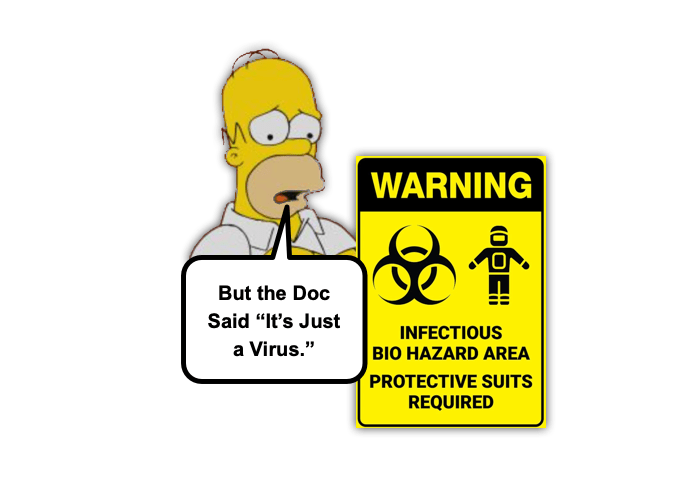Acute Flaccid Myelitis

Having just receive both my 2nd COVID Booster and Flu Vaccinations I have been feeling pretty “immune-ready-for-the-world!” Then, one of my colleagues at Carolinas Medical Center / Levine Children’s Hospital reminded me that there are many more viruses out there… and that they can also do a lot of harm (thank you Michelle Kerr, MPAS, PA-C, DFAAPA). We have previously discussed how the phrase “It’s Just a Virus” needs to be removed from our lexicon, because it neither conveys empathy nor reassurance. We have many examples of substantial issues related to viral illness (ex, Guillain-Barre, Myocarditis, Mollaret Meningitis, Severe Hand-Foot-Mouth Disease, Myositis), but in the past few years another condition has started to garner attention. Let us digest a quick tasty morsel on Acute Flaccid Myelitis:
Acute Flaccid Myelitis: Basics
Definition of:
- In 2014, the term “Acute Flaccid Myelitis” was coined and aimed to help characterize presentations that were similar to Polio, but without poliovirus being found. [Ayers, 2019]
- Until the 1950’s, Polio was a leading cause of Acute Flaccid Paralysis in the US.
- Then… came… VACCINES in 1955!
- In summer of 2014, there were several cases of Acute Flaccid Paralysis in Colorado. [Ayers, 2019]
- Extensive testing did not reveal clear etiology, but…
- Concurrent outbreak of Enterovirus EV-D68 was noted to be associated.
- Subsequent outbreak occurrences peak in Late summer to Early Fall.
- Until the 1950’s, Polio was a leading cause of Acute Flaccid Paralysis in the US.
- The Center for Disease Control defines Acute Flaccid Myelitis (AFM) as: [Vawter-Lee, 2021]
- Acute Flaccid Limb Weakness with
- Spinal Cord Lesions in the Gray Matter on MRI
- There may be some white matter involvement.
- Alternative diagnoses ruled-out.
Presentation of:
- It starts like so many other stories… with a Viral Prodrome!
- Upper respiratory and/or Gastrointestinal symptoms are common.
- Symptoms often precede development of AFM by 1 to 2 weeks.
- Weakness develops rapidly.
- May be one or more extremities
- Often more proximal weakness (so don’t just check for grip strength!)
- Loss of muscle tone and deep tendon reflexes can be seen (so… check DTRs!)
- Other findings can also occur:
- Pain in the affected extremity
- Headache
- Stiff neck
- Cranial Nerves can be involved
- Facial droop
- Difficulty moving eyes
- Difficulty swallowing
- Slurred speech
- Weak cry
Complications of:
- Respiratory distress (can progress rapidly… so these children do not get discharged!)
- Hemodynamic and Temperature instability and other Neurologic decompensation
Associated with:
- Non-polio enteroviruses (EV-D68, EV-A71), Coxsackieviruses
- Flaviviruses (West Nile virus, Japanese encephalitis virus)
- Herpesviruses
- Adenoviruses
Acute Flaccid Myelitis: Distinct from GBS?
- Distinguishing between Acute Flaccid Myelitis (AFM) and Guillain-Barre-Syndrome (GBS) can be challenging. [Helfferich, 2021]
- Both typically have: [Helfferich, 2021]
- Rapidly progressive flaccid limb weakness
- Decreased Deep Tendon Reflexes
- A prodromal viral prodrome
- Monophasic course
- MRI with nerve root enhancement
- While there is overlap in clinical presentation, there are distinguishing features: [Helfferich, 2021]
- AFM may have:
- Progression stops over days
- Asymmetric weakness
- No sensory symptoms
- CSF pleocytosis
- Spinal Cord and Brain Stem Lesions on MRI
- GBS may have:
- Progression continues for 1-2 weeks
- Symmetric weakness
- Sensory symptoms present (unless pure motor GBS)
- Deymelinating polyneuropathy on EMG
- AFM may have:
- Some cases will fulfill clinical and diagnostic criteria for both AFM and GBS. [Helfferich, 2021]
Acute Flaccid Myelitis: Evaluation & Management
- THINK OF IT!
- Obviously, in the ED, we may not get the final diagnosis determined, but we must consider it if the presentation warrants it.
- Recent viral URI or GI symptoms should be inquired about.
- Need to be monitored CLOSELY for progressive weakness and any respiratory difficulties.
- Check DTRs and Strength!
- I know… I know… we all just want to ultrasound or CT everything… but a physical exam can be useful too!
- Don’t overlook the Cranial Nerves also!
- MRI is the imaging modality of choice. [Vawter-Lee, 2021]
- Gray Matter lesions in the anterior horn (predominantly)
- Some cases may have lesions noted in the brain as well.
- Labs: [Vawter-Lee, 2021]
- An Acute Flaccid Myelitis Protocol has been suggested and includes various labs that may prove to help eliminate other diagnoses.
- May defer lab results until MRI findings are known, unless imaging is to be “delayed.”
- Blood
- CBC, CMP
- Arbovirus Panel (including West Nile antibodies)
- Enterovirus PCR
- Aquaporin-4 antibody
- Anti-MOG antibody
- 1 tube to send to the CDC
- CSF
- Cell Count, Glucose, Protein, Culture
- Oligoclonal bands, IgG index, Meaning-encephalitis panel (viral panel)
- Aquaporin-4 antibody
- 1 extra mL for the CDC
- Stool and Respiratory swabs
- Lyme Disease, Cat Scratch, Rocky Mountain Spotted Fever evaluations also reasonable.
- An Acute Flaccid Myelitis Protocol has been suggested and includes various labs that may prove to help eliminate other diagnoses.
- Call your Friendly Neighborhood Pediatric Neurologist! [Vawter-Lee, 2021]
- REPORT TO THE CDC – click here for that.
Moral of the Morsel
- Never say “It’s Just a Virus.” Viruses have always been able to do terrible things.
- Do not be so quick to dismiss those “odd neuro complaints.” Consider Acute Flaccid Myelitis and ask more questions.
- Check those DTRs and Strength of all Muscle groups. Sometimes proximal muscle weakness may not be appreciated until you ask the child to get out of bed!
- Impress your Neuro Friends with your knowledge of how to distinguish between AFM and GBS. Why? Because you are a BOSS!

